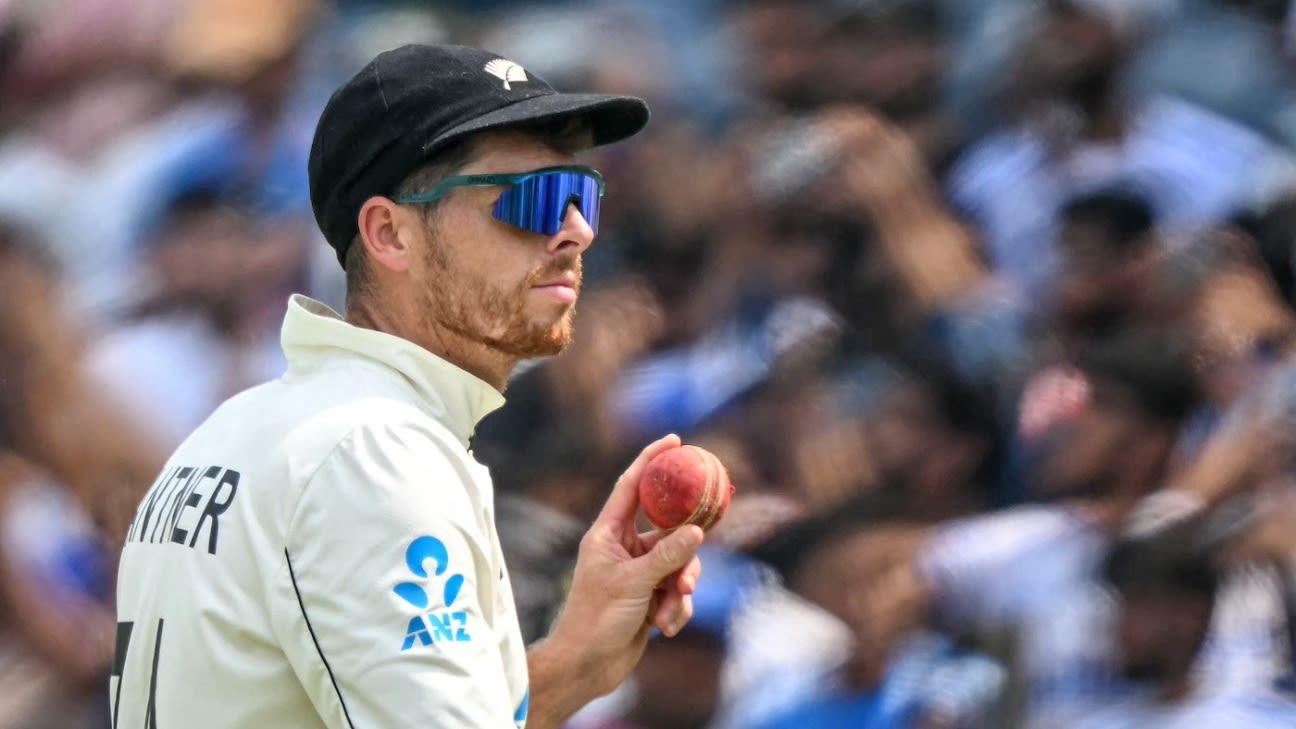Tea New Zealand 259 and 85 for 2 (Latham 37*, Ravindra 7*) lead India 156 (Jadeja 38, Santner 7-53, Phillips 2-26) by 188 runs
New Zealand took massive strides towards doing the unthinkable: not just their first series win in India but also India’s first series defeat at home in 12 years. They went into tea leading by 188 with eight second-innings wickets in hand.
So far ahead of the game were New Zealand that they could afford to make two DRS errors and also a questionable bowling choice when India were seven down. This is what happens when the pitch is doing enough and the opposition has runs on the board.
Right from the first three balls of the day, the challenge for India was apparent. From the same spot, the first one turned lesser than expected, the second one went straight on but Shubman Gill survived the umpire’s call, and the third one turned big past the outside edge. There was not just turn, but quick turn and natural variations from the surface.
For the first half hour, though, New Zealand’s patience and belief was tested. Gill managed to start breaking free with a six off Tim Southee after charging at him. Yashasvi Jaiswal drove Southee for a four before Ajaz Patel, the lead spinner on paper, offered him another half-volley. It turned around for them in the 22nd over of the day when Santner again beat Gill with one that went straight on. This time the umpire’s call went his way.
As the 15 seconds on the DRS timer lapsed, the crowd broke into a big cheer. For the arrival of Virat Kohli. The joy for them was short-lived as Kohli soon missed a full toss, which he tried to mow to square leg. The ball did drift in from the initial line, but it was still a full toss that Kohli would have dispatched almost every time had he played with a straighter bat.
By now the effect of the roller was wearing off. Batters were shanking even full balls or those that they got close to by using their feet. The ones that didn’t turn created further doubt. As it tends to happen at such times, fielders were everywhere; a hard sweep went straight into the shin of short leg, a short ball stopped and turned, and the pressure kept mounting.
With two left-hand batters in the middle, Latham went to Phillips post the first drinks break. It took Phillips four balls to turn one and take Jaiswal’s edge to slip. Rishabh Pant, who had been kept quiet with in-out fields, then went to pull one that was only slightly short of a length. The ball stayed low and bowled him, drawing an inaudible invective that might end up hitting Pant in the wallet.
Sarfaraz Khan, who showed proficiency against spin in Bengaluru, soon found out that the margin for error was little here. If you had to attack, you needed everything to go right. He tried to go inside-out to a really full ball, and it still spooned just over cover. His sweep was blocked, and brought him just singles. Eventually he tried to the clear the deepish mid-off without getting to the pitch of the ball, a reminder of Phillips’ dismissal on day one. A shooter then did R Ashwin in, the first time Santner went past three wickets in a Test innings.
India had lost 6 wickets for 53, and with two left-hand batters in the middle you would have expected more of the same from New Zealand. However, they went to Ajaz after lunch, which cost them 32 runs in four overs. They also missed a review off the second ball of the session from Santner, which gave Ravindra Jadeja a chance to score 17 more runs and end up on 38.
However, on a pitch where the ball was turning quickly and also staying straight at times, Santner kept attacking the stumps and kept producing enough chances. Jadeja was caught back to a full ball and trapped lbw. Santner’s slow teasing turn was too good for Akash Deep after the No. 10 had hit a six. The straighter one accounted for Jasprit Bumrah even as Washington Sundar took India past 150 by attacking Ajaz.
A lead of 103 here was a far worse scenario than the 356 in Bengaluru because this pitch was only going to get worse and India would have to bat last. New Zealand did some great frontrunning by attacking Ashwin immediately. This is what a deficit does to you. If you don’t take an early wicket, you don’t have enough fielders to protect the field and umpire’s calls tend to go the other way. Ashwin’s slower pace compared to Washington’s also let the batters use their feet, taking 33 runs off his first six overs.
When Washington beat Conway on the sweep and had him lbw for 17 off 25, he didn’t even realise he had got a bottom edge that would have saved him on the review. His replacement Young came in with similar intent, used his feet and also played sweeps of both kinds. By the time Ashwin came back and had him lbw just before tea, New Zealand had raced away to a lead of 181. Latham went into tea unbeaten on 37 off 60.
Sidharth Monga is a senior writer at ESPNcricinfo
